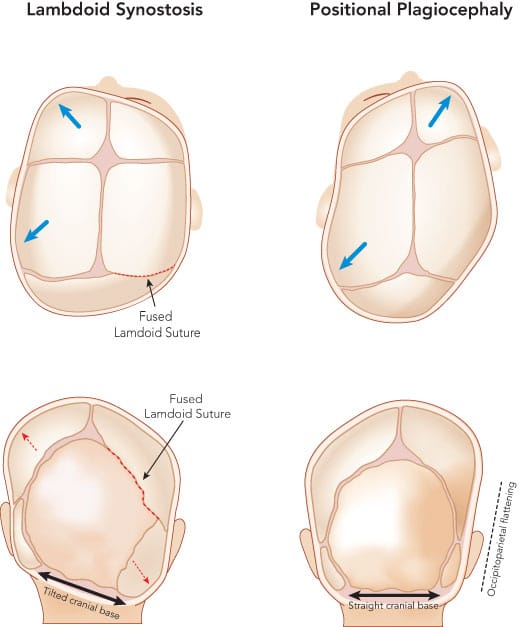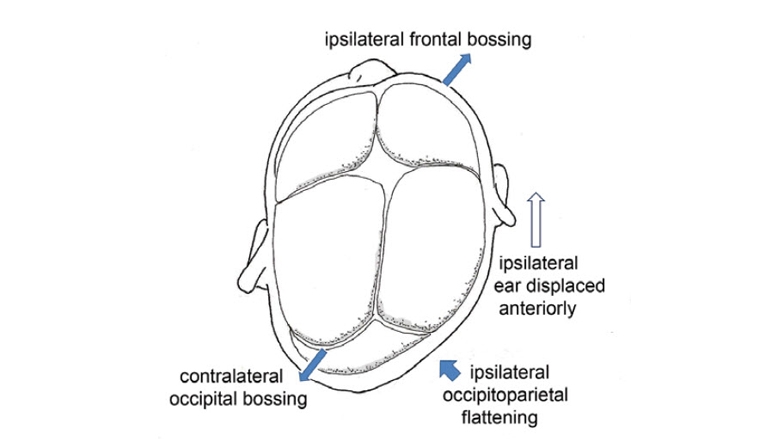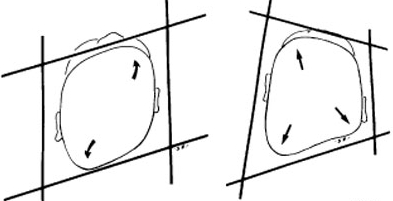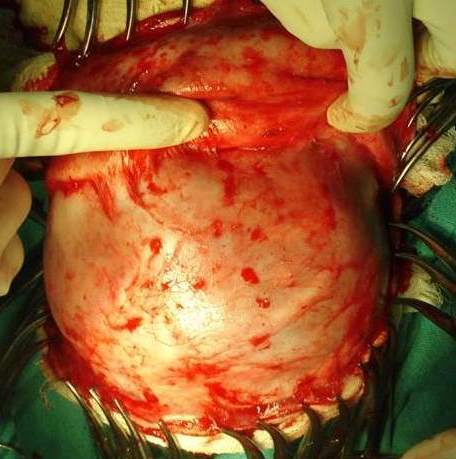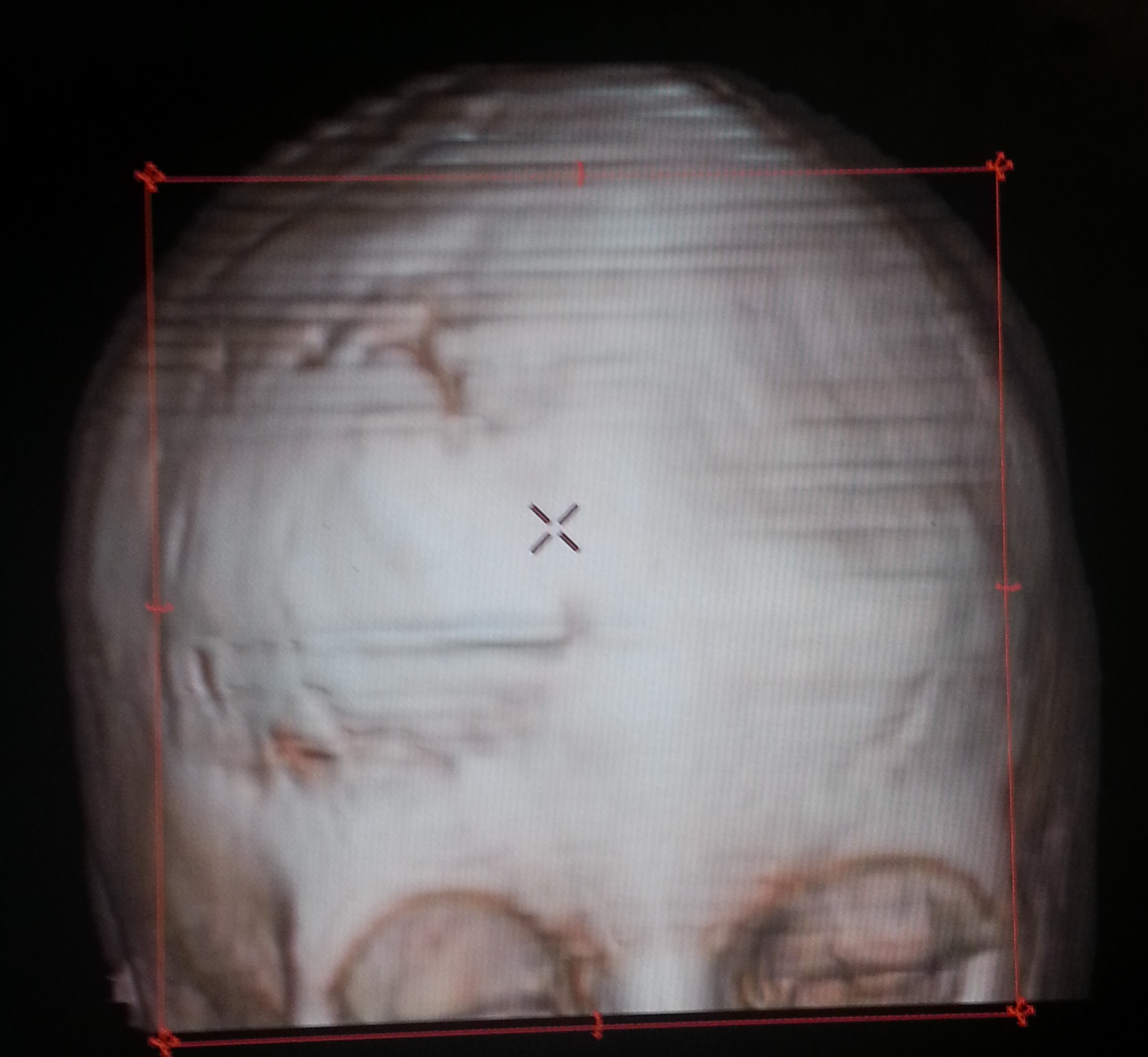[1]
Kim SY,Park MS,Yang JI,Yim SY, Comparison of helmet therapy and counter positioning for deformational plagiocephaly. Annals of rehabilitation medicine. 2013 Dec;
[PubMed PMID: 24466513]
[2]
Margulis A,Hatuel V,Weinberg A,Neuman A,Israel Z,Wexler MR, [Plagiocephaly in children: etiology, differential diagnosis and helmet treatment]. Harefuah. 1999 Apr 2;
[PubMed PMID: 15532593]
[3]
Kronig SAJ,Kronig ODM,Vrooman HA,Veenland JF,Van Adrichem LNA, Quantification of Severity of Unilateral Coronal Synostosis. The Cleft palate-craniofacial journal : official publication of the American Cleft Palate-Craniofacial Association. 2020 Oct 20;
[PubMed PMID: 33078622]
[4]
Orra S,Tadisina KK,Gharb BB,Rampazzo A,Doumit G,Papay F, The danger of posterior plagiocephaly. Eplasty. 2015;
[PubMed PMID: 25987949]
[6]
Timberlake AT,Persing JA, Genetics of Nonsyndromic Craniosynostosis. Plastic and reconstructive surgery. 2018 Jun;
[PubMed PMID: 29579021]
[7]
Greenwood J,Flodman P,Osann K,Boyadjiev SA,Kimonis V, Familial incidence and associated symptoms in a population of individuals with nonsyndromic craniosynostosis. Genetics in medicine : official journal of the American College of Medical Genetics. 2014 Apr;
[PubMed PMID: 24071792]
[8]
Garrocho-Rangel A,Manriquez-Olmos L,Flores-Velazquez J,Rosales-Berber MA,Martinez-Rider R,Pozos-Guillen A, Non-syndromic craniosynostosis in children: Scoping review. Medicina oral, patologia oral y cirugia bucal. 2018 Jul 1;
[PubMed PMID: 29924758]
Level 2 (mid-level) evidence
[9]
Hunenko O,Karmacharya J,Ong G,Kirschner RE, Toward an understanding of nonsyndromic craniosynostosis: altered patterns of TGF-beta receptor and FGF receptor expression induced by intrauterine head constraint. Annals of plastic surgery. 2001 May;
[PubMed PMID: 11352430]
Level 3 (low-level) evidence
[10]
Mulliken JB,Gripp KW,Stolle CA,Steinberger D,Müller U, Molecular analysis of patients with synostotic frontal plagiocephaly (unilateral coronal synostosis). Plastic and reconstructive surgery. 2004 Jun;
[PubMed PMID: 15253176]
[11]
Bialocerkowski AE,Vladusic SL,Wei Ng C, Prevalence, risk factors, and natural history of positional plagiocephaly: a systematic review. Developmental medicine and child neurology. 2008 Aug;
[PubMed PMID: 18754894]
Level 1 (high-level) evidence
[12]
De Bock F,Braun V,Renz-Polster H, Deformational plagiocephaly in normal infants: a systematic review of causes and hypotheses. Archives of disease in childhood. 2017 Jun;
[PubMed PMID: 28104626]
Level 1 (high-level) evidence
[13]
Jung BK,Yun IS, Diagnosis and treatment of positional plagiocephaly. Archives of craniofacial surgery. 2020 Apr;
[PubMed PMID: 32380806]
[14]
Di Rocco C,Paternoster G,Caldarelli M,Massimi L,Tamburrini G, Anterior plagiocephaly: epidemiology, clinical findings,diagnosis, and classification. A review. Child's nervous system : ChNS : official journal of the International Society for Pediatric Neurosurgery. 2012 Sep;
[PubMed PMID: 22872257]
[15]
Rhodes JL,Tye GW,Fearon JA, Craniosynostosis of the lambdoid suture. Seminars in plastic surgery. 2014 Aug;
[PubMed PMID: 25210507]
[16]
Borad V,Cordes EJ,Liljeberg KM,Sylvanus TS,Lim PK,Wood RJ, Isolated Lambdoid Craniosynostosis. The Journal of craniofacial surgery. 2019 Nov-Dec;
[PubMed PMID: 31633668]
[17]
Renz-Polster H,De Bock F, Deformational plagiocephaly: The case for an evolutionary mismatch. Evolution, medicine, and public health. 2018;
[PubMed PMID: 30151193]
Level 3 (low-level) evidence
[18]
Mawji A,Vollman AR,Fung T,Hatfield J,McNeil DA,Sauvé R, Risk factors for positional plagiocephaly and appropriate time frames for prevention messaging. Paediatrics
[PubMed PMID: 25382999]
[19]
Looman WS,Flannery AB, Evidence-based care of the child with deformational plagiocephaly, Part I: assessment and diagnosis. Journal of pediatric health care : official publication of National Association of Pediatric Nurse Associates
[PubMed PMID: 22726709]
[21]
Marshall JM, Shahzad F. Safe Sleep, Plagiocephaly, and Brachycephaly: Assessment, Risks, Treatment, and When to Refer. Pediatric annals. 2020 Oct 1:49(10):e440-e447. doi: 10.3928/19382359-20200922-02. Epub
[PubMed PMID: 33034660]
[22]
Kajdic N,Spazzapan P,Velnar T, Craniosynostosis - Recognition, clinical characteristics, and treatment. Bosnian journal of basic medical sciences. 2018 May 20;
[PubMed PMID: 28623672]
[23]
Ghizoni E,Denadai R,Raposo-Amaral CA,Joaquim AF,Tedeschi H,Raposo-Amaral CE, Diagnosis of infant synostotic and nonsynostotic cranial deformities: a review for pediatricians. Revista paulista de pediatria : orgao oficial da Sociedade de Pediatria de Sao Paulo. 2016 Dec;
[PubMed PMID: 27256993]
[24]
Smartt JM Jr,Reid RR,Singh DJ,Bartlett SP, True lambdoid craniosynostosis: long-term results of surgical and conservative therapy. Plastic and reconstructive surgery. 2007 Sep 15;
[PubMed PMID: 17805129]
[25]
Choi JW,Lim SY,Shin HJ, Craniosynostosis in Growing Children : Pathophysiological Changes and Neurosurgical Problems. Journal of Korean Neurosurgical Society. 2016 May;
[PubMed PMID: 27226849]
[26]
Tuite GF,Chong WK,Evanson J,Narita A,Taylor D,Harkness WF,Jones BM,Hayward RD, The effectiveness of papilledema as an indicator of raised intracranial pressure in children with craniosynostosis. Neurosurgery. 1996 Feb;
[PubMed PMID: 8869054]
[27]
Vannier MW,Hildebolt CF,Marsh JL,Pilgram TK,McAlister WH,Shackelford GD,Offutt CJ,Knapp RH, Craniosynostosis: diagnostic value of three-dimensional CT reconstruction. Radiology. 1989 Dec;
[PubMed PMID: 2813770]
[28]
Abboud H,Rifi L,Melhaoui A,Arkha Y,El Ouahabi A, Diagnosis, Management, and Outcome in 9 Children with Unilateral Posterior Synostotic Plagiocephaly. World neurosurgery. 2020 Aug;
[PubMed PMID: 32389879]
[29]
Khanna PC,Thapa MM,Iyer RS,Prasad SS, Pictorial essay: The many faces of craniosynostosis. The Indian journal of radiology
[PubMed PMID: 21431034]
[30]
Kim HJ,Roh HG,Lee IW, Craniosynostosis : Updates in Radiologic Diagnosis. Journal of Korean Neurosurgical Society. 2016 May;
[PubMed PMID: 27226852]
[31]
Sze RW,Hopper RA,Ghioni V,Gruss JS,Ellenbogen RG,King D,Hing AV,Cunningham ML, MDCT diagnosis of the child with posterior plagiocephaly. AJR. American journal of roentgenology. 2005 Nov;
[PubMed PMID: 16247160]
[32]
Captier G,Leboucq N,Bigorre M,Canovas F,Bonnel F,Bonnafé A,Montoya P, Plagiocephaly: morphometry of skull base asymmetry. Surgical and radiologic anatomy : SRA. 2003 Jul-Aug;
[PubMed PMID: 14504821]
[34]
Kalra R,Walker ML, Posterior plagiocephaly. Child's nervous system : ChNS : official journal of the International Society for Pediatric Neurosurgery. 2012 Sep;
[PubMed PMID: 22872253]
[35]
O'Broin ES,Allcutt D,Earley MJ, Posterior plagiocephaly: proactive conservative management. British journal of plastic surgery. 1999 Jan;
[PubMed PMID: 10343585]
[36]
Clarren SK,Smith DW,Hanson JW, Helmet treatment for plagiocephaly and congenital muscular torticollis. The Journal of pediatrics. 1979 Jan;
[PubMed PMID: 758420]
[37]
Goh JL,Bauer DF,Durham SR,Stotland MA, Orthotic (helmet) therapy in the treatment of plagiocephaly. Neurosurgical focus. 2013 Oct;
[PubMed PMID: 24079781]
[38]
Tamber MS,Nikas D,Beier A,Baird LC,Bauer DF,Durham S,Klimo P Jr,Lin AY,Mazzola C,McClung-Smith C,Mitchell L,Tyagi R,Flannery AM, Guidelines: Congress of Neurological Surgeons Systematic Review and Evidence-Based Guideline on the Role of Cranial Molding Orthosis (Helmet) Therapy for Patients With Positional Plagiocephaly. Neurosurgery. 2016 Nov;
[PubMed PMID: 27759675]
Level 1 (high-level) evidence
[39]
Esparza J,Hinojosa J,García-Recuero I,Romance A,Pascual B,Martínez de Aragón A, Surgical treatment of isolated and syndromic craniosynostosis. Results and complications in 283 consecutive cases. Neurocirugia (Asturias, Spain). 2008 Dec;
[PubMed PMID: 19112545]
Level 3 (low-level) evidence
[40]
Noto M,Imai K,Masuoka T,Sakahara D,Kunihiro N, Retrospective Review and Analysis of Complications Due to Cranial Distraction for Craniosynostosis. The Journal of craniofacial surgery. 2020 Nov 4;
[PubMed PMID: 33156168]
Level 2 (mid-level) evidence
[41]
Arts S,Delye H,van Lindert EJ, Intraoperative and postoperative complications in the surgical treatment of craniosynostosis: minimally invasive versus open surgical procedures. Journal of neurosurgery. Pediatrics. 2018 Feb;
[PubMed PMID: 29171801]
[42]
MacKinnon S,Proctor MR,Rogers GF,Meara JG,Whitecross S,Dagi LR, Improving ophthalmic outcomes in children with unilateral coronal synostosis by treatment with endoscopic strip craniectomy and helmet therapy rather than fronto-orbital advancement. Journal of AAPOS : the official publication of the American Association for Pediatric Ophthalmology and Strabismus. 2013 Jun;
[PubMed PMID: 23791406]
[43]
Huang MH,Gruss JS,Clarren SK,Mouradian WE,Cunningham ML,Roberts TS,Loeser JD,Cornell CJ, The differential diagnosis of posterior plagiocephaly: true lambdoid synostosis versus positional molding. Plastic and reconstructive surgery. 1996 Oct;
[PubMed PMID: 8823012]
[44]
Mathijssen IM, Guideline for Care of Patients With the Diagnoses of Craniosynostosis: Working Group on Craniosynostosis. The Journal of craniofacial surgery. 2015 Sep;
[PubMed PMID: 26355968]

